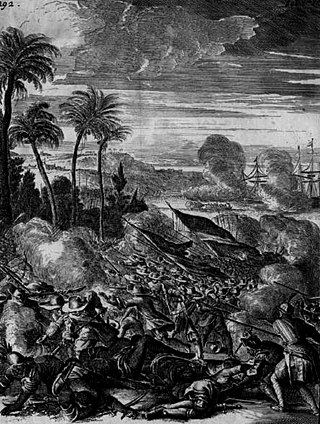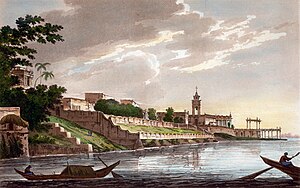
The United East India Company, commonly known as the Dutch East India Company, was a chartered trading company and one of the first joint-stock companies in the world. Established on 20 March 1602 by the States General of the Netherlands amalgamating existing companies, it was granted a 21-year monopoly to carry out trade activities in Asia. Shares in the company could be purchased by any citizen of the United Provinces and then subsequently bought and sold in open-air secondary markets. The company possessed quasi-governmental powers, including the ability to wage war, imprison and execute convicts, negotiate treaties, strike its own coins, and establish colonies. Also, because it traded across multiple colonies and countries from both the East and the West, the VOC is sometimes considered to have been the world's first multinational corporation.

The Coromandel Coast is the southeastern coastal region of the Indian subcontinent, bounded by the Utkal Plains to the north, the Bay of Bengal to the east, the Kaveri delta to the south, and the Eastern Ghats to the west, extending over an area of about 22,800 square kilometres. The coast has an average elevation of 80 metres and is backed by the Eastern Ghats, a chain of low lying and flat-topped hills.

Colonial India was the part of the Indian subcontinent that was occupied by European colonial powers during the Age of Discovery. European power was exerted both by conquest and trade, especially in spices. The search for the wealth and prosperity of India led to the colonisation of the Americas after Christopher Columbus went to the Americas in 1492. Only a few years later, near the end of the 15th century, Portuguese sailor Vasco da Gama became the first European to re-establish direct trade links with India by being the first to arrive by circumnavigating Africa. Having arrived in Calicut, which by then was one of the major trading ports of the eastern world, he obtained permission to trade in the city from the Saamoothiri Rajah. The next to arrive were the Dutch, with their main base in Ceylon. Their expansion into India was halted after their defeat in the Battle of Colachel to the Kingdom of Travancore, during the Travancore–Dutch War.

The Dutch colonial empire comprised the overseas territories and trading posts controlled and administered by Dutch chartered companies—mainly the Dutch East India Company and the Dutch West India Company—and subsequently by the Dutch Republic (1581–1795), and by the modern Kingdom of the Netherlands after 1815. It was initially a trade-based system which derived most of its influence from merchant enterprise and from Dutch control of international maritime shipping routes through strategically placed outposts, rather than from expansive territorial ventures. The Dutch were among the earliest empire-builders of Europe, following Spain and Portugal and one of the wealthiest nations of that time.

Joan Maetsuycker was the Governor of Zeylan during the Dutch period in Ceylon, and Governor-General of the Dutch East Indies from 1653 to 1678.

Bengal was a directorate of the Dutch East India Company in Mughal Bengal between 1610 until the company's liquidation in 1800. It then became a colony of the Kingdom of the Netherlands until 1825, when it was relinquished to the British according to the Anglo-Dutch Treaty of 1824. Dutch presence in the region started by the establishment of a trading post at Pipili in the mouth of Subarnarekha River in Odisha. The former colony is part of what is today called Dutch India. Bengal was the source of 50% of the textiles and 80% of the raw silk imported from Asia by the Dutch.

The Dutch–Portuguese War was a global armed conflict involving Dutch forces, in the form of the Dutch East India Company, the Dutch West India Company, and their allies, against the Iberian Union, and after 1640, the Portuguese Empire. Beginning in 1598, the conflict primarily involved the Dutch companies and fleet invading Portuguese colonies in the Americas, Africa, and the East Indies. The war can be thought of as an extension of the Eighty Years' War being fought in Europe at the time between Spain and the Netherlands, as Portugal was in a dynastic union with Spain after the War of the Portuguese Succession, for most of the conflict.

Dutch Ceylon was a governorate established in present-day Sri Lanka by the Dutch East India Company. Although the Dutch managed to capture most of the coastal areas in Sri Lanka, they were never able to control the Kingdom of Kandy located in the interior of the island. Dutch Ceylon existed from 1640 until 1796.

Rijcklof Volckertsz. van Goens was the Governor of Zeylan and Governor-General of the Dutch East Indies. He was the Governor of Zeylan from 12 May 1660 to 1661, then in 1663 and finally from 19 November 1664 to 1675 during the Dutch period in Ceylon. He was also served as Council Member of India during 1679. Van Goens’ managed to monopolize the cinnamon trade, get hold of the Malabar pepper and drive away the Portuguese from Ceylon and the Coromandel Coast for the VOC.

Pieter de Bitter was a 17th-century Dutch officer of the Dutch East India Company. On 12 August 1665 he won the Battle of Vågen against an English flotilla commanded by Thomas Teddeman.

The Dutch Empire is a term comprising different territories that were controlled by the Netherlands from the 17th to 20th centuries. They settled outside Europe with skills in trade and transport. In the late 16th century, the Netherlands reclaimed their lead at sea, and by the second half of the 17th century, dominated it. This hundred-year period is called the Dutch Golden Age. The Dutch built their empire with corporate colonialism by establishing the Dutch East India Company (VOC) and the Dutch West India Company (GWC), following Britain's footsteps, which led to war between both empires. After the French Revolutionary Wars, the Netherlands lost most of its power to the British after the French armies invaded the Netherlands and parts of the Dutch colonies. Hence, Dutch leaders had to defend their colonies and homeland. Between 1795 and 1814, the French restored the VOC in Indonesia and Suriname which remained under Dutch control.

Pieter van den Broecke was a Dutch cloth merchant in the service of the Dutch East India Company (VOC), and one of the first Dutchmen to taste coffee. He also went to Angola three times. He was one of the first Europeans to describe societies in West and Central Africa and in detail trade strategies along the African coast.

The History of Pulicat revolves around the early role of Pulicat as a seaport in one of the few natural harbours on the Coromandel Coast of South India. Pulicat is in Tamil Nadu at the mouth of Pulicat lake. Worth a visit to AARDE Pulicat Museum located in Kottai Kuppam road at Pazhaverkadu will give the detailed account on the history of Pulicat.

Dutch Suratte, officially Nederlandse vestiging van Suratte, was a directorate of the Dutch East India Company between 1616 and 1795, with its main factory in the city of Surat. Surat was an important trading city of the Mughal Empire on the river Tapti, and the Portuguese had been trading there since 1540. In the early 17th century, Portuguese traders were displaced by English and Dutch traders.

Fort Geldria or Fort Geldaria, located in Pulicat, Tamil Nadu, was the seat of the Dutch Republic's first settlement in India, and the capital of Dutch Coromandel. It was built by the Dutch East India Company in 1613 and became the local governmental centre in 1616. It was named for Geldria, the native province of Wemmer van Berchem, the General Director of the company. Regularly protected by a garrison of 80 to 90 men, Fort Geldria was the only fortification in the Indian empire; all other positions of the Dutch Company were trading posts.

Dutch Malabar also known by the name of its main settlement Cochin, were a collection of settlements and trading factories of the Dutch East India Company on the Malabar Coast between 1661 and 1795, and was a subdivision of what was collectively referred to as Dutch India. Dutch presence in the Malabar region started with the capture of Portuguese Quilon, expanded with the Conquest of Malabar (1658-1663), and ended with the conquest of Malabar by the British in 1795. They possessed military outposts in 11 locations: Alleppey, Ayacotta, Chendamangalam, Pappinivattom, Ponnani, Pallipuram, Cranganore, Chetwai, Cannanore, Cochin, and Quilon.

Coromandel was a governorate of the Dutch East India Company on the coasts of the Coromandel region from 1610, until the company's liquidation in 1798. Dutch presence in the region began with the capture of Pulicat from the Portuguese in Goa and Bombay-Bassein. Coromandel remained a colony of the Kingdom of the Netherlands until 1825, when it was relinquished to the British according to the Anglo-Dutch Treaty of 1824. It was part of what is today called Dutch India.

India–Netherlands relations are the foreign relations between India and the Netherlands. India maintains an embassy in The Hague, Netherlands and the Netherlands maintains an embassy in New Delhi and a consulate general in Mumbai. Both countries established diplomatic relations in 1947.
Daniel Anthony Overbeek was the last resident of Dutch Bengal between 1817 and 1825.

The Conquest of Malabar (1658-1663) encompassed a series of military campaigns led by Rijckloff van Goens with the objective of acquiring Portuguese-controlled territories along the Malabar Coast. The Dutch pursued these campaigns with determination, ultimately achieving success in their endeavor. As a result, the Dutch secured control over various regions along the Malabar Coast, marking a significant shift in the regional geopolitical landscape























